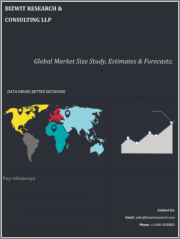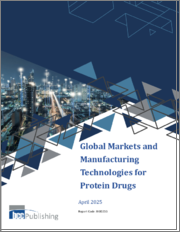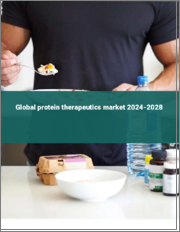
|
시장보고서
상품코드
1381647
세계의 단백질 치료제 시장 규모 조사 및 예측 : 제품별, 용도별, 지역별 분석(2023-2030년)Global Protein Therapeutics Market Size Study & Forecast, by Product, By Application, and Regional Analysis, 2023-2030 |
||||||
세계 단백질 치료제 시장은 2022년 약 3,253억 5,000만 달러로 평가되며, 예측 기간인 2023-2030년 동안 7.1% 이상의 건전한 성장률을 보일 것으로 예상됩니다.
단백질 치료제는 단백질 또는 펩타이드를 기반으로 한 치료제 그룹을 말합니다. 단백질은 면역 기능, 신진대사, 세포 신호 전달 등 다양한 생물학적 기능에 필수적인 필수 분자입니다. 이러한 치료 화합물은 수용체, 효소, 신호 전달 분자와 같은 특정 신체 표적과 상호 작용하여 질병, 장애 및 병리를 치료하는 것을 목표로 합니다. 양호한 규제 환경, 노인 인구의 증가, 생물학적 제제 분야의 개척과 더불어 의료 지출의 증가는 전 세계 시장 수요를 촉진하는 주요 요인입니다.
또한, 암, 당뇨병, 심혈관 질환, 자가 면역 질환과 같은 만성 질환의 유병률 증가는 추정 기간 동안 단백질 치료제에 대한 수요를 촉진하고 있으며, National Cancer Institute에 따르면 2018년 암 환자 수는 1,810만 명으로 추정되며, 2040년에는 2,950만 명에 달할 것으로 예상됩니다. 또한, 국제당뇨병연맹(IDF)의 보고에 따르면 2021년에는 약 5억 3,700만 명의 성인(20-79세)이 당뇨병을 앓고 있다고 합니다. 또한 2030년에는 6억 4,300만 명, 2045년에는 7억 8,300만 명으로 늘어날 것으로 예상하고 있습니다. 따라서 이들 질환은 일반적으로 단백질 치료제와 같은 표적화된 개별화 치료 접근법을 필요로 하며, 이에 따라 시장 성장도 상당 부분 증가할 것으로 보입니다. 또한, 생명공학 및 단백질 공학의 발전과 단백질 공학 연구의 성장은 향후 몇 년 동안 다양한 유리한 기회를 제공할 것으로 예상됩니다. 그러나 높은 생산 비용과 복잡한 제조 공정은 2023-2030년 예측 기간 동안 시장 성장에 도전이 될 것으로 보입니다.
세계 단백질 치료제 시장 조사에서 고려된 주요 지역은 아시아태평양, 북미, 유럽, 라틴아메리카, 중동 및 아프리카를 포함합니다. 북미는 생명공학 신흥 시장의 발전, 연구 개발 활동을 위한 자금 조달 증가, 주요 기업의 존재로 인해 2022년 시장을 장악했습니다. 반면, 아시아태평양은 예측 기간 동안 가장 높은 CAGR로 성장할 것으로 예상됩니다. 빠르게 증가하는 노인 인구, 단백질 치료제에 대한 환자의 인식 증가, 만성 질환의 유병률 증가는 이 지역의 시장 수요를 크게 촉진하고 있습니다.
이 조사의 목적은 최근 몇 년간 다양한 부문과 국가의 시장 규모를 파악하고 향후 몇 년간 시장 규모를 예측하는 것입니다. 이 보고서는 조사 대상 국가의 산업의 질적, 양적 측면을 포함하도록 설계되었습니다.
또한 시장의 미래 성장을 규정하는 촉진요인과 과제와 같은 중요한 측면에 대한 자세한 정보도 제공합니다. 또한, 주요 기업의 경쟁 상황과 제품 제공에 대한 상세한 분석과 함께 이해관계자들이 투자할 수 있는 미시적 시장에서의 잠재적 기회도 포함합니다.
목차
제1장 주요 요약
제2장 세계의 단백질 치료제 시장 정의와 범위
- 조사 목적
- 시장 정의와 범위
- 산업의 진화
- 조사 범위
- 조사 대상 연도
- 통화 환산율
제3장 세계의 단백질 치료제 시장 역학
- 단백질 치료제 시장의 영향 분석(2020-2030년)
- 시장 성장 촉진요인
- 생물제제 분야 발전
- 만성질환 증가
- 시장 과제
- 높은 제조 비용이 필요
- 복잡한 제조 공정
- 시장 기회
- 바이오테크놀러지와 단백질 공학 진보 상승
- 프로테오믹스 연구 성장
- 시장 성장 촉진요인
제4장 세계의 단백질 치료제 시장 산업 분석
- Porter's 5 Force 모델
- 공급 기업의 교섭력
- 구매자의 교섭력
- 신규 참여업체의 위협
- 대체품의 위협
- 경쟁 기업 간의 경쟁 관계
- Porter's 5 Force 영향 분석
- PEST 분석
- 정치
- 경제
- 사회
- 기술
- 환경
- 법률
- 주요 투자 기회
- 주요 성공 전략
- COVID-19 영향 분석
- 파괴적 동향
- 업계 전문가의 관점
- 애널리스트의 결론과 제안
제5장 단백질 치료제 세계 시장 : 제품별
- 시장 현황
- 단백질 치료제 세계 시장 : 제품별, 실적 - 잠재성 분석
- 단백질 치료제 세계 시장, 제품별, 추정·예측, 2020-2030년
- 단백질 치료제 시장, 하위 부문 분석
- 단클론항체
- 인슐린
- 융합 단백질
- 에리스로포이에틴
- 인터페론
- 인간성장호르몬
- 난포자극호르몬
제6장 단백질 치료제 세계 시장 : 용도별
- 시장 현황
- 단백질 치료제 세계 시장 : 용도별, 실적 - 잠재성 분석
- 단백질 치료제 세계 시장, 용도별, 추정·예측, 2020-2030년
- 단백질 치료제 시장, 하위 부문 분석
- 대사질환
- 면역질환
- 암
- 호르몬질환
- 유전질환
- 기타
제7장 단백질 치료제 세계 시장, 지역 분석
- 주요 국가
- 주요 신흥 국가
- 단백질 치료제 시장, 지역별 시장 현황
- 북미
- 미국
- 제품, 추정·예측, 2020-2030년
- 용도별, 추정·예측, 2020-2030년
- 캐나다
- 미국
- 유럽의 단백질 치료제 시장 현황
- 영국
- 독일
- 프랑스
- 스페인
- 이탈리아
- 기타 유럽
- 아시아태평양의 단백질 치료제 시장 현황
- 중국
- 인도
- 일본
- 호주
- 한국
- 기타 아시아태평양
- 라틴아메리카의 단백질 치료제 시장 현황
- 브라질
- 멕시코
- 중동 및 아프리카
- 사우디아라비아
- 남아프리카공화국
- 기타 중동 및 아프리카
제8장 경쟁 정보
- 주요 기업 SWOT 분석
- 주요 시장 전략
- 기업 개요
- Novo Nordisk AS
- 주요 정보
- 개요
- 재무(데이터 가용성에 따라 다름)
- 제품 개요
- Baxter International Inc.
- Amgen Inc.
- Merck and Co., Inc.
- Sanofi S.A.
- Eli Lilly And Company
- Abbott Laboratories
- Pfizer Inc.
- Johnson and Johnson(Janssen Pharmaceuticals)
- F. Hoffmann La Roche Ltd
- Novo Nordisk AS
제9장 조사 과정
- 조사 과정
- 데이터 광업
- 분석
- 시장 추정
- 검증
- 출판
- 조사 속성
- 조사 가정
Global Protein Therapeutics Market is valued at approximately USD 325.35 billion in 2022 and is anticipated to grow with a healthy growth rate of more than 7.1% over the forecast period 2023-2030. Protein therapeutics refers to a class of therapeutic agents that are based on proteins or peptides. Proteins are substantial molecules that are crucial for a variety of biological functions, such as immune function, metabolism, and cell signaling. These therapeutic compounds are intended to treat illnesses, disorders, or medical conditions by interacting with certain bodily targets, such as receptors, enzymes, or signaling molecules. The favorable regulatory environment, increase in the geriatric population, and development of the biologics sector, coupled with the rise in healthcare expenditure are the key factors that are spurring the market demand across the globe.
Additionally, the rising prevalence of chronic diseases, such as cancer, diabetes, cardiovascular disorders, and autoimmune diseases is propelling the demand for protein therapeutics during the estimated period. According to National Cancer Institute, in 2018, the number of cancer patients is estimated to account for 18.1 million, which is projected to reach 29.5 million patients by the year 2040. Moreover, the International Diabetic Federation (IDF) reported that in 2021 approximately 537 million adults (20-79 years) are living with diabetes. Also, the total number of people living with diabetes is expected to increase to 643 million by 2030 and 783 million by 2045. Thus, these conditions generally require targeted and personalized treatment approaches like protein therapeutics, which, in turn, augment the market growth at a considerable rate. Furthermore, the rising advancements in biotechnology and protein engineering, as well as the growth in proteomic research present various lucrative opportunities over the forecasting years. However, the high production costs required and the complex manufacturing processes are challenging the market growth throughout the forecast period of 2023-2030.
The key regions considered for the Global Protein Therapeutics Market study include Asia Pacific, North America, Europe, Latin America, and Middle East & Africa. North America dominated the market in 2022 owing to the increasing advancements in biotechnology, growing funding for research and development activities, along with the presence of key players in the region. Whereas, Asia Pacific is expected to grow at the highest CAGR over the forecasting years. The rapidly growing geriatric population, increasing patient awareness toward protein therapeutics, as well as rising prevalence of chronic diseases are significantly propelling the market demand across the region.
Major market players included in this report are:
- Novo Nordisk AS
- Baxter International Inc.
- Amgen Inc.
- Merck and Co., Inc.
- Sanofi S.A.
- Eli Lilly And Company
- Abbott Laboratories
- Pfizer Inc.
- Johnson and Johnson (Janssen Pharmaceuticals)
- F. Hoffmann La Roche Ltd
Recent Developments in the Market:
- In December 2022, Enlaza Therapeutics announced the introduction with USD 61 million in financing with the objective of advancing the company's first covalent biologic therapeutic platform. The company integrated novel innovations that allow the introduction of proprietary unnatural amino acids to protein drugs, which allows specific covalent binding to their target proteins.
Global Protein Therapeutics Market Report Scope:
- Historical Data - 2020 - 2021
- Base Year for Estimation - 2022
- Forecast period - 2023-2030
- Report Coverage - Revenue forecast, Company Ranking, Competitive Landscape, Growth factors, and Trends
- Segments Covered - Product, Application, Region
- Regional Scope - North America; Europe; Asia Pacific; Latin America; Middle East & Africa
- Customization Scope - Free report customization (equivalent up to 8 analyst's working hours) with purchase. Addition or alteration to country, regional & segment scope*
The objective of the study is to define market sizes of different segments & countries in recent years and to forecast the values to the coming years. The report is designed to incorporate both qualitative and quantitative aspects of the industry within countries involved in the study.
The report also caters detailed information about the crucial aspects such as driving factors & challenges which will define the future growth of the market. Additionally, it also incorporates potential opportunities in micro markets for stakeholders to invest along with the detailed analysis of competitive landscape and product offerings of key players. The detailed segments and sub-segment of the market are explained below:
By Product:
- Monoclonal Antibodies
- Insulin
- Fusion Protein
- Erythropoietin
- Interferon
- Human Growth Hormone
- Follicle Stimulating Hormone
By Application:
- Metabolic Disorders
- Immunologic Disorders
- Cancer
- Hormonal Disorders
- Genetic Disorders
- Others
By Region:
- North America
- U.S.
- Canada
- Europe
- UK
- Germany
- France
- Spain
- Italy
- ROE
- Asia Pacific
- China
- India
- Japan
- Australia
- South Korea
- RoAPAC
- Latin America
- Brazil
- Mexico
- Middle East & Africa
- Saudi Arabia
- South Africa
- Rest of Middle East & Africa
Table of Contents
Chapter 1. Executive Summary
- 1.1. Market Snapshot
- 1.2. Global & Segmental Market Estimates & Forecasts, 2020-2030 (USD Billion)
- 1.2.1. Protein Therapeutics Market, by Region, 2020-2030 (USD Billion)
- 1.2.2. Protein Therapeutics Market, by Product, 2020-2030 (USD Billion)
- 1.2.3. Protein Therapeutics Market, by Application, 2020-2030 (USD Billion)
- 1.3. Key Trends
- 1.4. Estimation Methodology
- 1.5. Research Assumption
Chapter 2. Global Protein Therapeutics Market Definition and Scope
- 2.1. Objective of the Study
- 2.2. Market Definition & Scope
- 2.2.1. Industry Evolution
- 2.2.2. Scope of the Study
- 2.3. Years Considered for the Study
- 2.4. Currency Conversion Rates
Chapter 3. Global Protein Therapeutics Market Dynamics
- 3.1. Protein Therapeutics Market Impact Analysis (2020-2030)
- 3.1.1. Market Drivers
- 3.1.1.1. Development of the biologics sector
- 3.1.1.2. Rising prevalence of chronic diseases
- 3.1.2. Market Challenges
- 3.1.2.1. High production costs required
- 3.1.2.2. Complex manufacturing processes
- 3.1.3. Market Opportunities
- 3.1.3.1. Rising advancements in biotechnology and protein engineering
- 3.1.3.2. Growth in proteomic research
- 3.1.1. Market Drivers
Chapter 4. Global Protein Therapeutics Market Industry Analysis
- 4.1. Porter's 5 Force Model
- 4.1.1. Bargaining Power of Suppliers
- 4.1.2. Bargaining Power of Buyers
- 4.1.3. Threat of New Entrants
- 4.1.4. Threat of Substitutes
- 4.1.5. Competitive Rivalry
- 4.2. Porter's 5 Force Impact Analysis
- 4.3. PEST Analysis
- 4.3.1. Political
- 4.3.2. Economical
- 4.3.3. Social
- 4.3.4. Technological
- 4.3.5. Environmental
- 4.3.6. Legal
- 4.4. Top investment opportunity
- 4.5. Top winning strategies
- 4.6. COVID-19 Impact Analysis
- 4.7. Disruptive Trends
- 4.8. Industry Expert Perspective
- 4.9. Analyst Recommendation & Conclusion
Chapter 5. Global Protein Therapeutics Market, by Product
- 5.1. Market Snapshot
- 5.2. Global Protein Therapeutics Market by Product, Performance - Potential Analysis
- 5.3. Global Protein Therapeutics Market Estimates & Forecasts by Product 2020-2030 (USD Billion)
- 5.4. Protein Therapeutics Market, Sub Segment Analysis
- 5.4.1. Monoclonal Antibodies
- 5.4.2. Insulin
- 5.4.3. Fusion Protein
- 5.4.4. Erythropoietin
- 5.4.5. Interferon
- 5.4.6. Human Growth Hormone
- 5.4.7. Follicle Stimulating Hormone
Chapter 6. Global Protein Therapeutics Market, by Application
- 6.1. Market Snapshot
- 6.2. Global Protein Therapeutics Market by Application, Performance - Potential Analysis
- 6.3. Global Protein Therapeutics Market Estimates & Forecasts by Application 2020-2030 (USD Billion)
- 6.4. Protein Therapeutics Market, Sub Segment Analysis
- 6.4.1. Metabolic Disorders
- 6.4.2. Immunologic Disorders
- 6.4.3. Cancer
- 6.4.4. Hormonal Disorders
- 6.4.5. Genetic Disorders
- 6.4.6. Others
Chapter 7. Global Protein Therapeutics Market, Regional Analysis
- 7.1. Top Leading Countries
- 7.2. Top Emerging Countries
- 7.3. Protein Therapeutics Market, Regional Market Snapshot
- 7.4. North America Protein Therapeutics Market
- 7.4.1. U.S. Protein Therapeutics Market
- 7.4.1.1. Product breakdown estimates & forecasts, 2020-2030
- 7.4.1.2. Application breakdown estimates & forecasts, 2020-2030
- 7.4.2. Canada Protein Therapeutics Market
- 7.4.1. U.S. Protein Therapeutics Market
- 7.5. Europe Protein Therapeutics Market Snapshot
- 7.5.1. U.K. Protein Therapeutics Market
- 7.5.2. Germany Protein Therapeutics Market
- 7.5.3. France Protein Therapeutics Market
- 7.5.4. Spain Protein Therapeutics Market
- 7.5.5. Italy Protein Therapeutics Market
- 7.5.6. Rest of Europe Protein Therapeutics Market
- 7.6. Asia-Pacific Protein Therapeutics Market Snapshot
- 7.6.1. China Protein Therapeutics Market
- 7.6.2. India Protein Therapeutics Market
- 7.6.3. Japan Protein Therapeutics Market
- 7.6.4. Australia Protein Therapeutics Market
- 7.6.5. South Korea Protein Therapeutics Market
- 7.6.6. Rest of Asia Pacific Protein Therapeutics Market
- 7.7. Latin America Protein Therapeutics Market Snapshot
- 7.7.1. Brazil Protein Therapeutics Market
- 7.7.2. Mexico Protein Therapeutics Market
- 7.8. Middle East & Africa Protein Therapeutics Market
- 7.8.1. Saudi Arabia Protein Therapeutics Market
- 7.8.2. South Africa Protein Therapeutics Market
- 7.8.3. Rest of Middle East & Africa Protein Therapeutics Market
Chapter 8. Competitive Intelligence
- 8.1. Key Company SWOT Analysis
- 8.1.1. Company 1
- 8.1.2. Company 2
- 8.1.3. Company 3
- 8.2. Top Market Strategies
- 8.3. Company Profiles
- 8.3.1. Novo Nordisk AS
- 8.3.1.1. Key Information
- 8.3.1.2. Overview
- 8.3.1.3. Financial (Subject to Data Availability)
- 8.3.1.4. Product Summary
- 8.3.1.5. Recent Developments
- 8.3.2. Baxter International Inc.
- 8.3.3. Amgen Inc.
- 8.3.4. Merck and Co., Inc.
- 8.3.5. Sanofi S.A.
- 8.3.6. Eli Lilly And Company
- 8.3.7. Abbott Laboratories
- 8.3.8. Pfizer Inc.
- 8.3.9. Johnson and Johnson (Janssen Pharmaceuticals)
- 8.3.10. F. Hoffmann La Roche Ltd
- 8.3.1. Novo Nordisk AS
Chapter 9. Research Process
- 9.1. Research Process
- 9.1.1. Data Mining
- 9.1.2. Analysis
- 9.1.3. Market Estimation
- 9.1.4. Validation
- 9.1.5. Publishing
- 9.2. Research Attributes
- 9.3. Research Assumption

















